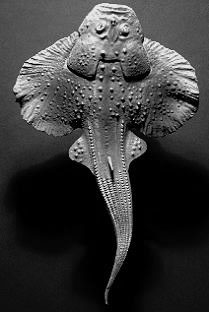 Return
Return
Gemuendina

GEMUENDINA
The rounded, flattened body of this early bottom-dwelling placoderm (of the rhenanid order) was remarkably like that of a modern ray. Its pectoral fins were drawn out into winglike lobes on either side of its body, and the eyes and nostrils were repositioned on the top of the head.
These features were duplicated about 260 million years later in an unrelated group of fishes - the rays and skates that dwelt on the seabed from Jurassic times onward. Here is an excellent example of convergent evolution - in which unrelated creatures adopt the same structure, and often the same habits, in response to a similar environment and lifestyle.
Gemuendina did not have the heavy armor of its later relatives. A mosaic of small bony plates covered its body, decorated with sharp, defensive denticles; a few large plates were developed above and below the head. This placoderm also lacked the characteristic tooth plates of its later relatives. Instead, the jaws were equipped with star-shaped tubercles, which acted like teeth; the jaws could be protruded out of the mouth to pick up sea urchins and shellfish from the seabed, which were then crushed between the teethlike tubercles.
┬®1988 Marshall Editions Limited
® Palaeontological Museum, University of Oslo, Norway, 2001(fossil image)
.
 Return
Return
